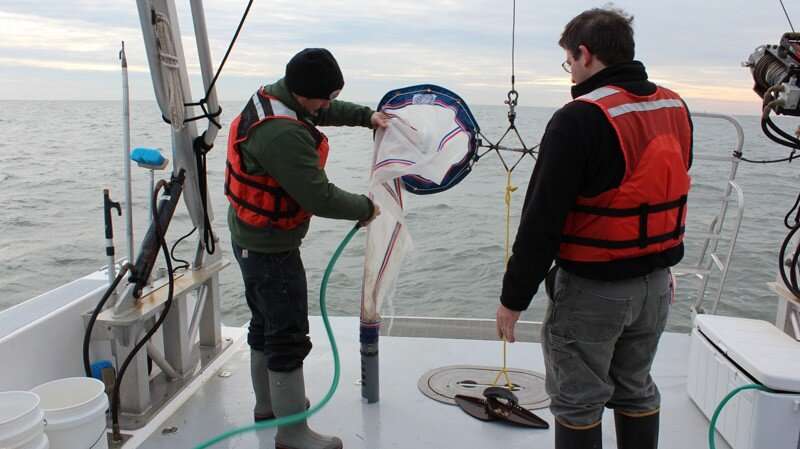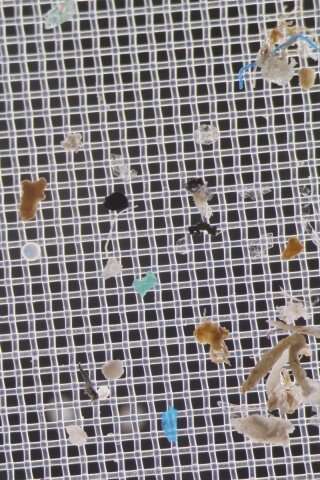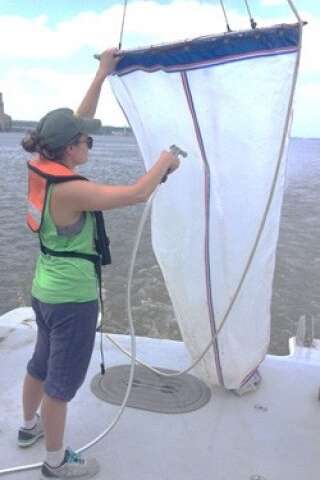Estuarine and coastal environments play a crucial role in microplastic concentrations
by Science X staff
Every year, about 8 million metric tons of plastic are put into the world's oceans. Of particular concern are microplastics, materials found in the marine environment that occur in sizes below five millimeters and are the most abundant form of marine debris observed at the ocean surface.
Estuarine and coastal environments play a crucial role as a buffer between land, freshwater environments and the open ocean where plastic debris accumulates. Despite performing this critical function, estuarine and coastal environments have not been extensively studied for microplastic prevalence and impact.
To help better understand how these environments are affected by microplastics, University of Delaware researchers looked at microplastics in the Delaware Bay, which is a tide-, wind- and freshwater-driven estuarine environment.
They discovered a substantial concentration of microplastics in the Delaware Bay that accumulate in hotspots driven by buoyancy, winds and tides, all of which lead to high variability of microplastic distributions (across space and time) in the bay.
The results of their study were published in the Environmental Science and Technology academic journal.
The project was led by Jonathan Cohen and Tobias Kukulka, associate professors in the College of Earth, Ocean and Environment (CEOE), as well as CEOE master's students Anna Internicola and R. Alan Mason.
Cohen said that since this is an area of intense public interest, with possible government regulations of microplastics in the future, it's critical that there's science upon which to base politically and economically important decisions.
"If these decisions are going to be happening and the public is going to have to weigh in on them, there needs to be science that the decisions can be based on," said Cohen. "That's a pretty strong motivating factor for us."
Complementary expertise
The work started in 2016 with a mini-grant from Delaware Sea Grant to assess microplastics in the Delaware Bay, which led to a two-year grant to assess the impact microplastics are having on the ecology of the Delaware Bay.

Kukulka and Cohen have complementary expertise and research approaches, with Cohen focused on biology and field work and Kukulka focused on the physical aspects of oceanography and the modeling work.
Cohen and Internicola measured the distribution of microplastics from 16 sampling sites across the Delaware Bay, ranging from just above the Delaware Memorial Bridge in Wilmington to outside the bay mouth. The stations cover the area encompassing where the bay is fresh water to where the bay meets the Atlantic Ocean.
The researchers used a net to get surface samples, towing the net at the surface and using a flow meter inside the net to indicate how much water was sampled. They then rinsed the net, preserved the samples in a glass container and brought them back to the lab.
Chemical methods in the lab allowed the researchers to separate the plastics from the organics by dissolving the organic material and putting samples in a salty solution where the plastics would float and the organics would sink.
Kukulka and Mason then took the data from the samples and plugged it into their hydrological models.
By combining the observational data with tidal-, wind- and buoyancy-driven models to simulate the distribution of microplastics, they were able to extrapolate the results to a larger portion of the Delaware Bay and determine how particles move within the bay, exit the bay or accumulate in surface convergence regions.
Cohen said the sampling and modeling approach speaks to how marine science is conducted.
"It's not all about going on boats and collecting a bucket of water or dipping a net," Cohen said. "It's about combining what you can learn from that with what you can learn from these numerical approaches."
Kukulka agreed, saying that it is great to be able to combine the field sampling data with the modeling.
"It's challenging to do observations bay-wide, and sampling is time-limited and limited to a specific location," said Kukulka. "We didn't really get a broad snapshot bay-wide with sampling, but with the modeling, we can see the temporal variability and the whole spatial coverage of plastics."

Salinity fronts
In the area where the fresher water from the Delaware River meets the saltier water of the Atlantic Ocean, the researchers observed salinity fronts, with fresh water on top and saltier water on the bottom. Near such fronts, surface currents can converge.
Known as convergence zones, the researchers found microplastics in high concentrations in these areas.
"What we find in the simulation is that we have regions of very high concentrations, much higher than outside those convergence zones," said Kukulka.
Because the buoyant microplastics float on top of the water, they are also influenced and accumulate in areas due to the tides and the wind. Plastics move within the tidal cycle back and forth as tides move in and out of the bay, causing tremendous locational variability over a tidal cycle, especially if a researcher is measuring just inside or outside of those hotspots.
"You can stay at a given spot and sample a given location or station, but that patch of material isn't always going to be there," said Cohen. "It's going to move with the tides, and so you could be at a given station and based on the simulations, you could see a one-thousand times change in the concentrations."
The distribution of the plastics also depends on the force of the winds, with a strong wind moving microplastics to various areas of the bay.
"If we know the forcing, we can make educated guesses on where we might expect plastics and where they're likely to accumulate," said Kukulka.
Next steps
As for the project's next steps, they would like to definitively determine how long microplastics stay in the bay and if they end up at the shores of New Jersey and Delaware or if they're trapped within the bay.
Journal information: Environmental Science and Technology
Provided by University of Delaware